The Effect of Carrier Liquid Composition on the Molecular Properties of Caseinate Solutions Studied by AF4
The effect of carrier liquid composition on the molecular properties of uncross-linked and enzymatically cross-linked caseinate solutions was studied by asymmetrical flow field-flow fractionation (AF4).
The effect of carrier liquid composition on the molecular properties of uncross-linked and enzymatically cross-linked caseinate solutions was studied by asymmetrical flow field-flow fractionation (AF4). The sample solutions were prepared in 0.1M NaCl solution and subjected to AF4 analysis using three different elution buffers: 0.1 M NaCl, 0.01 M NaCl, and 0.01M CaCl2. When using 0.1 M NaCl as the carrier liquid, AF4 enabled the separation of the main casein aggregates from larger species (probably residual phospholipids) according to their molar masses, which increase smoothly over the elution times. In contrast, a decrease in the ionic strength of the carrier liquid caused significant changes in the elution properties of the caseinate solutions as a result of variations in the molecular conformations of the aggregates. Our findings extend the knowledge on the molecular properties of complex caseinate solutions as well as point out potential challenges when analyzing dynamic natural systems with an AF4 method.
Caseinate, a water-soluble casein product, is a mixture of the four primary casein proteins, αs1-, αs2-, β-, and κ-caseins (molar mass ~ 2 × 104 g/mol), in a ratio of approximately 4:1:4:1 (1). Solutions of caseinates possess excellent functional properties that are of fundamental importance for a wide range of applications in food (nutritive supplements), confectioneries (foam stabilizers), glues (thickener agents), and pharmaceutics (drug delivery) (2). Studies on the molecular properties of caseinate solutions have been widely performed using batch dynamic light scattering (DLS) techniques providing size distributions in terms of hydrodynamic radius (Rh) (3). It has been shown that, in a caseinate solution, individual caseins form a dynamic system of small aggregates with an average Rh of ~ 10 nm as well as larger aggregates with an Rh of ~ 200 nm as a consequence of noncovalent interactions (3,4). Although LS methods provide a fast measurement of aggregate size in solution, they only yield average values and can hardly give a proper molecular characterization in the case of polydisperse samples. Yet, exact information about molar mass and conformation of individual components in caseinates is crucial to better understand the aggregation behaviours of caseins in solution as well as to develop structure–function relationships. Therefore, a separation step prior to LS analysis is needed to overcome the difficulties in analyzing caseinate solutions.
Asymmetrical flow field-flow fractionation (AF4) is an analytical technique that has, in the past decade, clearly shown to be a powerful alternative to columnâbased separation methods for the separation and characterization of colloidal properties of ultra-large milk protein aggregates under native conditions (5). In a recent work, we demonstrated the capabilities of AF4 to investigate the enzymatic cross-linking of non-micellar caseins with microbial transglutaminase (mTGase) (6). Through coupling of AF4 to multi-angle light scattering (MALS), DLS, and concentration detectors such as UV–vis and refractive index (RI), we were able to elucidate the impact of mTGase on the molecular structure of protein aggregates, which changes in a controlled manner during enzymatic treatments, from flexible to compact and much denser network-like objects (6).
The advantageous characteristics of AF4 for the analysis of dynamic natural systems mainly come from the lack of stationary phase. The sample fractionation is performed in an empty channel offering the following benefits: a “gentle” separation mechanism with severely reduced pressures and shear forces; higher molar mass separation range (approximately 103 to 1012 g/mol); and the possibility to apply non-denaturing eluents for a non-destructive analysis of native proteins. The theoretical background and the different separation modes of AF4 have been comprehensively reviewed over the years (7,8,9), and the method was presented particularly for the separation of caseins in our previous work (5).
The AF4 separation mechanism is based on differences in the diffusion coefficient (D), which is related to the hydrodynamic size (Rh) of the molecules according to the Stokes-Einstein equation (10):

where kB is the Boltzmann constant, T is the temperature, and η is the viscosity of the carrier liquid.
Taking into account the AF4 retention theory (11) and combining with the previous equation, the elution time (tE) is related to Rh by the following equation:

where w is the channel thickness, Fx is the cross-flow velocity, and Fc is the channel flow velocity. The ratio between Fx and Fc defines the separation power, and it has to be optimized to obtain reliable size separation in a relatively short analysis time. Programmed cross-flow with linear or exponential decay over the time is used for the separation of highly distributed samples, whereas constant cross-flow enables the separation of monomers from aggregates (12). Besides the flow rates, however, other parameters in AF4 should be optimized to achieve good separation and characterization. These parameters include the membrane type (cut-off and material), channel thickness, sample volume injected, and focusing time (13). Additionally, the choice of carrier liquid is also crucial to obtain reliable AF4 data and should be selected according to the properties of the sample. For protein analysis, buffer solutions are commonly used to reduce electrostatic interactions that may affect the sample components and cause poor fractionation (5,7). Furthermore, the composition of the carrier liquid has been shown to affect the stability of delicate protein aggregates (14) as well as to induce changes in molecular structure of charged particles (15).
This article aims to understand the impact of the AF4 carrier liquid on the molecular properties of uncross-linked and enzymatically cross-linked caseinate solutions. Molar masses, sizes, and conformation of aggregates as a function of changes in composition of the carrier liquids are characterized through coupling of AF4 to MALS, on-line DLS, and concentration detectors. The results are expected to provide more insights into the complex properties of caseinate systems as well as to extend knowledge of AF4 applications for the analysis of biological macromolecules.
Experimental Section
Chemicals: Acid casein powder was purchased by SigmaâAldrich Chemie GmbH, with a crude protein content of 868 g/kg (Kjeldahl method, N × 6.38 [IDF, 1979]). NaCl (anhydrous), NaOH, and NaN3 were purchased by Sigma Aldrich, whereas CaCl2 (dehydrated) was purchased by (Carl Roth GmbH + Co. KG). Microbial transglutaminase Activa MP from Streptomyces mobaraensis (mTGase; activity of 90 U/g of protein) was purchased by Ajinomoto Foods Europe SAS.
Carrier Liquids and Caseinate Preparation: All the carrier liquids were prepared using deionized 18.2 M½-cm water (Lab Water Purification Systems - ELGA LabWater). Three different AF4 carrier liquids were prepared as follow:
Dissolution of 11.69 g of NaCl in 2 L of deionized water to obtain a 0.1 M NaCl solution.
Dissolution of 1.17 g of NaCl in 2 L of deionized water to obtain a 0.01 M NaCl solution.
Dissolution of 2.22 g of CaCl2 in 2 L of deionized water to obtain a 0.01 M CaCl2 solution.
In any case, 0.2 g of NaN3 was added to the solution for preservation, and the pH was adjusted to 6.8 using a freshly prepared solution of 1 M NaOH. Prior to AF4 experiments, the carrier liquids were filtered using 0.2 µm pore size cellulose acetate filters (Sartorius Stedim BioTech GmbH).
For the preparation of caseinate solution, commercial casein powder was dispersed at 10 mg/mL in 0.1 M NaCl and neutralized at pH 6.8 using 1 M NaOH solution. Thereafter, the caseinate solution was stirred overnight at room temperature to ensure complete dissolution of caseins. For the enzymatic cross-linking, a part of the solution was treated with 3 U mTGase per g casein at 40 °C. The enzyme was inactivated by heat treatment (85 °C for approximately 10 min) after 3 h (cross-linked caseinate). The reference caseinate was treated in the same way without enzyme addition (uncross-linked caseinate) (6).
Instrumentation: The AF4 instrument was an Eclipse Dualtec separation system (Wyatt Technology Europe GmbH) equipped with a flow reading unit and channel section. This consisted of a long channel (26.5 cm in length), poly(tetrafluoroethylene) (PTFE) spacer with a thickness of 490 μm, and regenerated cellulose (RC) ultra-filtration membrane with an average molecular weight cut-off (MWCO) of 10 kDa. The channel section was connected to an Optilab T-rEx (Wyatt Technology Europe GmbH) differential refractive index (dRI) detector with a wavelength of 658 nm, an 18-angle Dawn-Heleos II MALS detector (Wyatt Technology Europe GmbH) operating at a wavelength of 658 nm, and a UV detector (Agilent Technologies) set at wavelength of 280 nm. A Wyatt QELS module (Wyatt Technology Europe GmbH) integrated inside the Dawn provided online Rh distributions at a scattering angle of 99°. The carrier liquids were delivered by an Agilent Technologies 1200 series isocratic pump equipped with an in-line vacuum degasser, while an autosampler (1200 series, Agilent Technologies) ensured the injections into the channel. Between the pump and the channel a filter holder with a 100 nm pore size poly(vinylidene fluoride) (PVDF) membrane (Millipore Corp.) to prevent the contamination of the separation device was placed.
The programmed flow for AF4 experiments is shown in Figure 1. The channel flow rate was maintained at 0.5 mL/min for the entire AF4 run. The sample concentration was 10 mg/mL, and the amount of sample solution injected into the channel was optimized to 30 µL, which was tested to ensure no overloading of the channel.
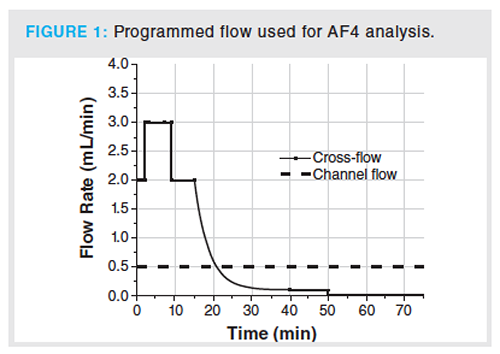
The solution was injected during the focus–injection step with a duration of 4 min, whereas a focusing–relaxation step of 2 min was performed prior to elution mode. The total focusing time was 7 min with a cross-flow rate (focusing flow) of 3 mL/min. Similar to our previous study (6), the crossâflow was initially maintained at 2 mL/min for 5 min, and then decreased exponentially to reach 0.1 mL/min in 25 min in elution mode. The cross-flow was kept constant at 0.1 mL/min for 10 min afterwards. At the end of each run, the channel was rinsed with the carrier liquid for 25 min without crossâflow to eliminate any particles prior to the next injection.
The control of the Agilent and Eclipse components (flows and pressures) as well as the acquisition and data analysis were carried out using the software Vision CSH package (Chromatography Software Hub, Version R1806; Wyatt Technology Europe GmbH). The AF4 experiments were performed in triplicate, that is, three injections for uncross-linked and cross-linked caseinate solutions.
Light Scattering Analysis: After AF4 fractionation, light scattering techniques are widely used in the field of proteins because they provide direct information on size and structural properties of the individual molecules and aggregates. In particular, the combination of MALS with concentration detectors enables the determination of molar mass, or more specifically weight average molar mass (Mw), and radius of gyration (Rg) according to the following equations (16):

where I(θ) is the intensity of light scattered by the molecule at angle θ, c is the concentration of the sample solution, dn⁄dc is the specific refractive index increment of the scattering solution, and P(θ) is the particle scattering function:

where λ is the wavelength of the incident light in a given solvent, and u is the scattering vector (16).
The calculation of Mw by MALS works generally well for protein aggregates of at least 1 × 104 g/mol and the angular dependence of the light scattering, for example, the determination of Rg of at least 10 nm (diameter > λ/20 nm). The MALS data can be fitted using different models of which Berry is commonly utilized for casein particles (5,17). In this work, the determination of Mw was performed using Berry formalism fitting a 1st degree polynomial to data obtained at 29.6–130.4° scattering angles, and an extinction coefficient of 0.81 L/g for caseinate solution (1).
As a third quantity, the Rh can be determined by on-line DLS, which substantially measures the frequency of the intensity fluctuations related to molecular diffusion, and thus to the Rh (equation 1). A significant advantage of having both DLS and MALS is that the first one is more sensitive to smaller aggregates (≤ 10 nm), and therefore a complete size distribution can be obtained by combining both detectors.
Additionally, assumptions about the molecular conformation of the proteins can be obtained from the dependency of radii on Mw:

The slope of a double logarithmic plot defines the scaling factor ν, which is theoretically defined for spheres (ν = 0.33), random coils (ν = 0.5-0.6), and stiff rods (ν ~ 1) (18).
Results and Discussion
Differences in the molecular properties of uncross-linked and cross-linked caseinate solutions with variation in the ionic strength as well as ion type of the AF4 carrier liquid were systematically studied. The impact of 0.1 M NaCl, 0.01 M NaCl, and 0.01 M CaCl2 elution buffers on the detector responses as well as on the Mw distributions of uncross-linked and crossâlinked caseinate solutions is shown in Figure 2. The Rg and Rh distributions as well as their average values are reported in Figure S1 and Table S1 (see supplementary material: http://www.chromatographyonline.com/supplementary-information-effect-carrier-liquid-compositionâmolecular-properties-caseinate-solutions). The variations of both radii with Mw (conformation plots) as a function of the carrier liquid compositions are shown in Figures 3, 4, and 5. The fractograms show that the elution behaviours of both uncross-linked and cross-linked caseinate solutions are strongly affected by variations in the composition of the carrier liquid used for AF4 analysis. Using a carrier liquid with identical composition as the sample preparation (0.1 M NaCl) allows high resolution separation of the main casein aggregate (at 20–35 min elution time) from larger aggregates eluting when cross-flow is off (at elution time of 50–60 min). The broader UV response at lower elution times (approximately less than 20 min) reveals the presence of casein material that is too small for a complete MALS analysis. The late-eluting fraction with relatively low UV activity but higher MALS response is likely a result of aggregation between proteins and residual phospholipids that are characteristics of the commercial casein powder (6,19). In fact, the zwitterionic phase of phospholipids molecules has been shown to interact with hydrophobic facets of κ-caseins located on the external surface of casein micelles in milk (20,21). Consequently, experimental conditions (for example, heat treatments) during milk processing to obtain the raw casein material might generate largerâsized complexes containing both casein proteins and lipid fractions, which are the cause of a high MALS response after AF4 separation.
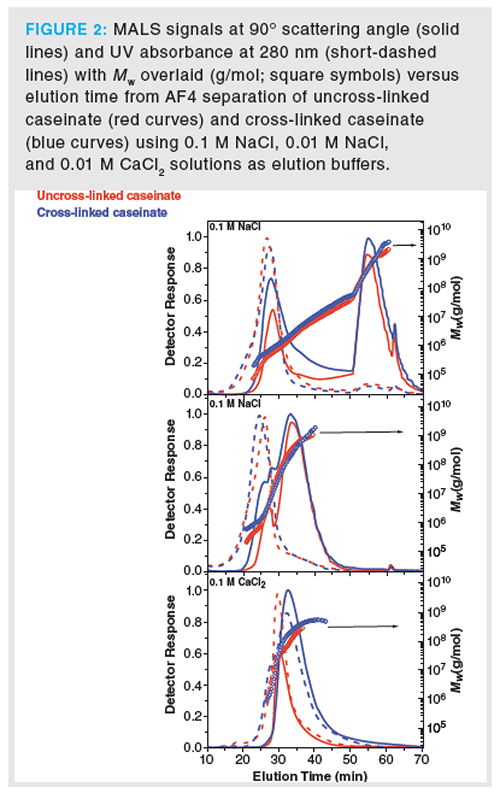

Casein aggregates in the uncross-linked caseinate possess an average Mw of 4.8 × 105 g/mol, which increases up to 1.02 × 106 g/mol after mTGase cross-linking (Table S1, see supplementary material: http://www.chromatographyonline.com/supplementary-information-effect-carrier-liquid-composition-molecular-properties-caseinate-solutions). Furthermore, the average Rh measured by DLS is 12.6 nm and 12.2 nm after mTGase cross-linking; Rg values for this low elution time fraction cannot be calculated because the sizes are smaller than 10 nm and are behind the limits of MALS (Figure S1, Table S1, see supplementary material: http://www.chromatographyonline.com/supplementary-information-effect-carrier-liquid-composition-molecular-properties-caseinate-solutions). Assumptions on the molecular conformations for casein aggregates can be made plotting Rh against Mw as shown in Figure 3. According to the theory, Rh is related to the diffusion coefficient of a hard sphere with the same volume (equation 1), whereas Rg is related to the geometrical dimension of a specific particle (5). It can be seen that casein aggregates possess compact molecular conformation (νRh = 0.40), which is rather unaffected by cross-linking reactions (νRh = 0.38). Such observations are in line with our previous studies, where we proved the hypothesis that mTGase forms cross-links between casein molecules predominantly within the same aggregates (6,19) However, the unavailability of Rg distributions does not allow further considerations to be made on the molecular shape of caseinate aggregates in this study. For larger aggregates, the average Mw increases from 6.4 × 108 g/mol to 8.7 × 108 g/mol, whereas the two radii show similar average values after enzymatic reaction (Table S1; see also Figure S1, see supplementary material: http://www.chromatographyonline.com/supplementary-information-effect-carrier-liquid-composition-molecular-properties-caseinate-solutions). The trend (ν > 0.4) of all the conformation plots indicates large aggregate formation with an overall lower compactness (Figure 3).
When the concentration of NaCl in the carrier liquid was decreased to 0.01 M, the peak associated to the larger aggregates shifted towards shorter elution times (Figure 2), resulting in a decrease of the average Mw to 8.3 × 107 g/mol (uncross-linked caseinate) and 1.5 × 108 g/mol (cross-linked caseinate) (Table S1, see supplementary material: http://www.chromatographyonline.com/supplementary-information-effect-carrier-liquid-composition-molecular-properties-caseinate-solutions). Additionally, both radii also decreased at lower ionic strength but the differences were not as significant as in the case of Mw (Table S1, see supplementary material: http://www.chromatographyonline.com/supplementary-information-effect-carrier-liquid-composition-molecular-properties-caseinate-solutions). The conformation plots, however, show that the larger aggregates become more compact as the slopes decrease to values ≤ 0.40 (Figure 4). In contrast, the average values of Mw and the radii for the main casein aggregate fraction prior to and after mTGase cross-linking do not drastically change when decreasing the ionic strength of the carrier liquid (Table S1, see supplementary material: http://www.chromatographyonline.com/supplementary-information-effect-carrier-liquid-composition-molecular-properties-caseinate-solutions), but the structures become slightly expanded with increasing conformation slopes (Figure 4). Interestingly, for the cross-linked caseinate, an additional peak (approximately 30 min elution time; Figure 2) with average Rg of 13.1 nm (Table S1, see supplementary material: http://www.chromatographyonline.com/supplementary-information-effect-carrier-liquid-composition-molecular-properties-caseinate-solutions) was detected using MALS. For this fraction, the conformation plot based on the dependency of Rg on Mw gives a slope of 0.64, which is typical for flexible molecular structures. However, the molar mass range available for fitting the LS data is rather small because of poor separation and thus, the higher slope values might be a result of a low accuracy.
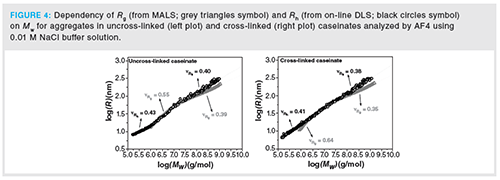
On the other hand, using salt-depleted carrier liquids causes a reduction in charge screening effects and thus increases electrostatic interactions during the AF4 analysis. In this context, the focusing step prior to elution could partially play an important role in changing the retention properties of caseinate solutions: during the focusing–relaxation step, the sample components undergo higher pressures and become concentrated from the cross-flow in a narrow band on the ultra-filtration membrane. Consequently, interactive moieties of caseins and other species can form different agglomerates that significantly affect the AF4 performance and separation. However, the selection of focus flow conditions with respect to the type of buffer for AF4 analysis of caseinates requires more detailed investigations that are beyond the scope of this study.
The elution behaviours of components in caseinate solutions are even more affected when using 0.01 M CaCl2 for AF4 separation (Figure 2). The presence of Ca2+ appears to greatly increase the interactions between casein material and larger aggregates, resulting in the formation of highly disperse species. In other studies, ion Ca2+ was added directly to caseinate solution, resulting in increased aggregation of individual caseins similar to native casein micelles (4,22). Furthermore, larger cross-linked casein aggregates were formed by mTGase in the presence of Ca2+ as a consequence of more pronounced self-assembly of casein molecules (23). The average value of Mw was 1.6 × 107 g/mol for the uncross-linked caseinate solution, and increased up to 8.7 × 107 g/mol for the cross-linked caseinate solution (average values of Mw can be seen in Table S1, see supplementary material: http://www.chromatographyonline.com/supplementary-information-effect-carrier-liquid-composition-molecular-properties-caseinate-solutions). The size distributions, however, show different tendencies (Figure S1, see supplementary material: http://www.chromatographyonline.com/supplementary-information-effect-carrier-liquid-composition-molecular-properties-caseinate-solutions) and the average values of radii calculated for uncrossâlinked caseinate were larger than those ones obtained for the cross-linked caseinate solution (Table S1, see supplementary material: http://www.chromatographyonline.com/supplementary-information-effect-carrier-liquid-composition-molecular-properties-caseinate-solutions). When plotting the radii against the molar mass for the uncross-linked caseinate, reliable scaling slopes were obtained in the region of Mw ≥ 2 × 107 g/mol (Figure 5).
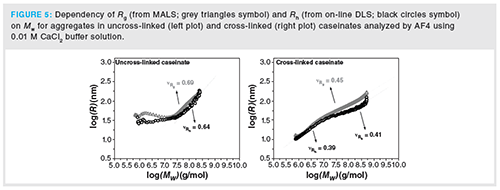
In the region of molar masses between 5 × 106 g/mol and 1 × 107 g/mol, no clear tendency was observed for the uncrossâlinked caseinate. This effect might be attributed to the formation of calcium bridges within the aggregates, resulting in a strong alteration of molecular conformations of the individual caseins. At higher Mw, however, both radii steeply increased with increasing Mw, which is typical for the formation of open structures (scaling factors > 0.6). In contrast, the dependency of both Rh and Rg on Mw for the cross-linked caseinate showed a decrease in conformation slopes, indicating the formation of more compact geometries. Whilst Rg increased constantly with increasing Mw, resulting in a slope value of 0.45, the Rh deviated slightly from linear behaviour at Mw ≥ 2 × 108 g/mol as reflected in the conformation value of 0.41 (Figure 5). This effect might be caused by ions Ca2+ of the carrier liquid that act on the external surface of cross-linked casein aggregates, and thus “mediate” stronger electrostatic interactions between individual caseins and residual phospholipids. In fact, it is rather unlikely that ions Ca2+ can diffuse within the aggregates because of the presence of cross-links induced by mTGase. However, it should be noted that the amount of Ca2+ in the buffer system was rather low but was sufficient to cause significant changes in AF4 performance during separation of caseinate components.
Conclusion
This study examined the impact of the carrier liquid composition used for AF4 analysis on the molecular properties of uncrossâlinked and cross-linked caseinate solutions. The sample solutions were prepared using 0.1 M NaCl solution and the same experimental conditions, whereas three carrier liquids were chosen for AF4 experiments: 0.1 M NaCl, 0.01M NaCl, and 0.01M CaCl2. The characterization of the eluted fractions was achieved through coupling AF4 with MALS-UVâonline DLS detection systems. Whilst a carrier liquid with the same composition of the sample preparation (0.1 M NaCl) enabled a size separation of main casein aggregates from larger aggregates (probably phospholipids–protein complexes), the decrease in the ionic strength of the buffer systems affected the molecular conformation and, thus, the retention properties of both components. Such modifications are attributed to stronger interactions between caseins and residual lipids at lower salt concentration of the carrier liquid, resulting in the formation of different agglomerates during AF4 analysis.
On the one hand, the obtained results extend the knowledge about aggregation behaviours and molecular properties of components in caseinate solutions. Furthermore, the importance of the carrier liquid composition when characterizing dynamic natural systems with AF4 has been demonstrated. In order to minimize changes in the molecular structures of the sample components and obtain a reliable AF4 separation, great care must be taken in the selection of the salt concentration and ion types in addition to flow conditions for method development.
Acknowledgements
This research was funded by the Deutsche Forschungsgemeinschaft (DFG; Bonn, Germany) under the grant number LE1424/9-1 and RO3454/5-1. Microbial transglutaminase was kindly provided by Ajinomoto Foods Europe SAS (Hamburg, Germany).
Author Contributions
The manuscript was written through contributions from all authors. All authors have given approval to the final version of the manuscript.
Conflict of Interest
The authors have declared no conflict of interest.
References
- A. Pitkowski, D. Durand, and T. Nicolai, J. Colloid Interface Sci.326, 96–102 (2008).
- A. Badem and G. Uçar, Int. J. Food Sci. Nutr.2(1), 4–9 (2017).
- A. HadjSadok, A. Pitkowski, L. Benyahia, T. Nicolai, and N. Moulai-Mostefa, Food Hydrocoll.22, 1460–1466 (2008).
- T. Huppertz, I. Gazi, H. Luyten, H. Nieuwenhuijse, A. Alting, and E. Schokker, Int. Dairy J.74, 1–11 (2017).
- N. Raak, R.A. Abbate, A. Lederer, H. Rohm, and D. Jaros, Separations 5(1), 14 (2018).
- R.A. Abbate, N. Raak, S. Boye, A. Janke, H. Rohm, D. Jaros, and A. Lederer, Food Hydrocoll.92, 117–124 (2019).
- K.G. Wahlund, J. Chromatogr. A1287, 97–112 (2013).
- M.I. Malik and H. Pasch, Prog. Polym. Sci.63, 42–85 (2016).
- D. Perez-Rea, C. Zielke, and L. Nilsson, J. Chromatogr. A1506, 131–141 (2017).
- A. Einstein, Ann. Phys. 17, 549–560 (1905).
- B. Wittgren and K.G. Wahlund, J. Chromatogr. A760, 205–218 (1997).
- M. Leeman, K.G. Wahlund, and B. Wittgren, J. Chromatogr. A1134, 236–245 (2006).
- M. Marioli and W.T. Kok, Anal. Bioanal. Chem. 411, 2327–2338 (2019).
- C.R.M. Bria and S.K.R. Williams, J. Chromatogr. A1465, 155–164 (2016).
- B. Kim, S. Woo, Y.-S. Park, E. Hwang, and M.-H. Moon, Anal. Bioanal. Chem.407(5), 1327–1334 (2015).
- B.H. Zimm, J. Chem. Phys.16, 1093 (1948).
- J.R. Runyon, M. Ulmius, and L. Nilsson, Colloid. Surface. A: Physicochem. Eng. Aspects442, 25–33 (2014).
- W. Burchard, in Branched Polymers II, J. Roovers, Ed. (Springer, Berlin, Germany, Vol. 143, 1999), pp. 113–194.
- N. Raak, L. Brehm, R.A. Abbate, T. Henle, A. Lederer, H. Rohm, and D. Jaros, Food Biosci.28, 89–98 (2019).
- M. Sokolovski, T. Sheynis, S. Kolusheva, and R. Jelinek, Biochim. Biophys. Acta Biomembr.1778(10), 2341–2349 (2008).
- A. Crespo-Villanueva, B. Gumí-Audenis, F. Sanz, F. Artzner, C. Mériadec, F. Rousseau, C. Lopez, M.I. Giannotti, and F. Guyomarc’h, Biochim. Biophys. Acta Biomembr.1860(12), 2588–2598 (2018).
- A. Smialowskaa, L. Matia-Merinoa, B. Inghamb, and A.J. Carra, Colloid. Surface. A: Physicochem. Eng. Aspects522, 113–123 (2017).
- N. Raak, C. Schöne, H. Rohm, and D. Jaros, Food Hydrocoll.86, 43-49 (2019).
Albena Lederer is a scientist in the analytical department of the Institute of Macromolecular Chemistry at IPF Dresden and head of the Polymer Separation Group.
Susanne Boye is a scientist in the Polymer Separation Group and leader of thermoanalysis as well as fieldâflow fractionation techniques at IPF Dresden.
Raffaele Andrea Abbate carried out his Ph.D. in the Polymer separation group at the IPF Dresden. He is currently working as an application scientist at Wyatt Technology Europe.
Mahmoud Alkhalaf worked as a lab technician and research engineer in the Polymer separation group at IPF Dresden.
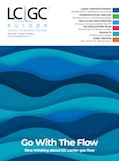
A Guide to (U)HPLC Column Selection for Protein Analysis
April 16th 2025Analytical scientists are faced with the task of finding the right column from an almost unmanageable range of products. This paper focuses on columns that enable protein analysis under native conditions through size exclusion, hydrophobic interaction, and ion exchange chromatography. It will highlight the different column characteristics—pore size, particle size, base matrices, column dimensions, ligands—and which questions will help decide which columns to use.
The Benefits of Custom Bonded Silica
April 1st 2025Not all chromatography resins are created equal. Off-the-shelf chromatography resins might not always meet the rigorous purification requirements of biopharmaceutical manufacturing. Custom bonded silica from Grace can address a wide range of separation challenges, leading to real performance improvements. Discover more about the latest innovations in chromatography silica from Grace, including VYDAC® and DAVISIL®.
5 Things to Consider When Selecting a Chromatography Silica
April 1st 2025Particularly in the pharmaceutical industry, drug purity isn’t just a goal – it’s essential for achieving safety, stability and efficacy. However, purification is easier said than done, especially with challenging molecules like DNA and RNA “oligonucleotides,” due in large part to their diversity and the range of impurities that can be generated during production. Enter DAVISIL® chromatographic silica, with a wide range of pore diameters and particle sizes to meet your specific application, performance and sustainability requirements. Before you choose the chromatography resin for your next purification application, take a look at these 5 considerations.
Automating Protein Purification: Efficiency, Yield, and Reproducibility
March 27th 2025Recent advancements in automated protein purification stress the importance of efficiency, scalability, and yield consistency. This eBook compares different purification platforms, highlighting their impact on downstream applications and demonstrating how automation enhances throughput and process control.




